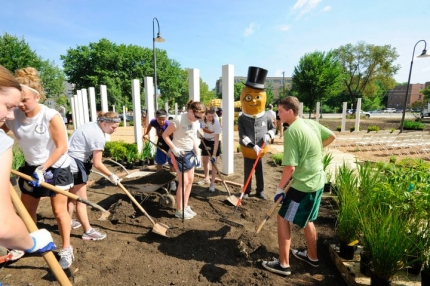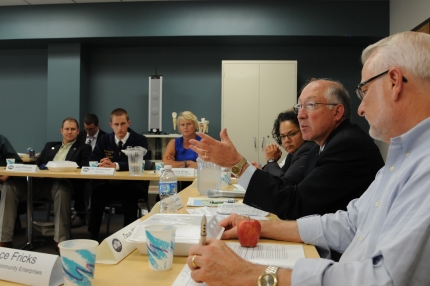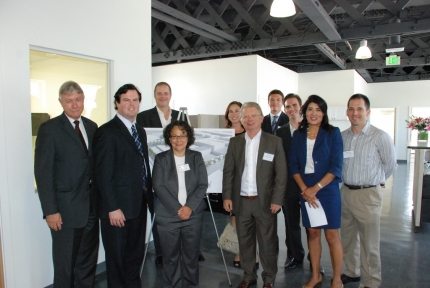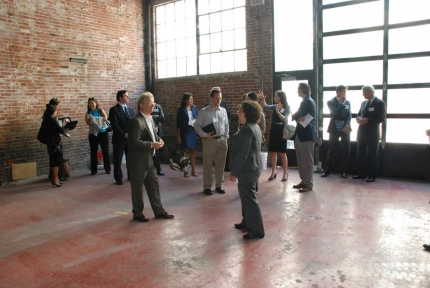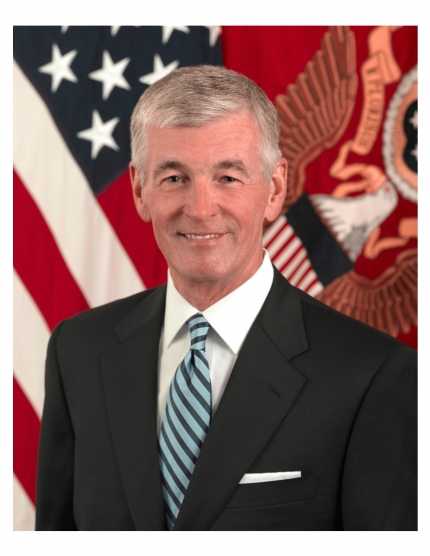Council on Environmental Quality Blog
America's Great Outdoors: Homegrown Community Revitalization
Posted by on August 19, 2011 at 3:10 PM EDTRecently, I had the pleasure of joining forces with White House Council on Environmental Quality Chair Nancy Sutley and several other leaders in Washington, D.C., including Mayor Vincent Gray and Congresswoman Eleanor Holmes Norton, to open a new urban park in the Northeast community of Lincoln Heights. Once an unused and overrun piece of land that attracted illegal activity, the space has been transformed into a sustainable and welcoming outdoor park through a partnership between Planters and The Corps Network, the national nonprofit I lead that represents the country's service and conservation corps.
For the past month, we have brought together our local member Corps including Washington Parks & People, Earth Conservation Corps and the Student Conservation Association to work in tandem with the private sector, city government, community organizations and local residents to bring the vision of the park—called a Planters Grove—to life. Borne out of the ideas and goals laid out in the President's America’s Great Outdoors initiative, it is so much more than simply a new park. It is a nexus of neighborhood revitalization, community service and outdoor activity, and proof that public-private partnerships can seed community transformation and growth.
We know this transformation of community transforms lives. Built by the local member Corps noted above, the park has already contributed to the employment and training of young people in Washington at a time when we know our country's youth face tremendous challenges and disadvantages. For example, one young woman who helped us build, Ashley, is originally from the Lincoln Heights neighborhood. After an abusive childhood, she has recently graduated from the Earth Conservation Corps, is now attending college and preparing to be a social worker and, through motivational speaking, is giving peers and youth inspiration through her story. Just one of several Corps members involved in the project, Ashley is representative of the powerful and lasting change these young people are driving in their communities and in themselves through this project.
Service and learning will continue to define the Planters Grove for years to come. The opportunities to engage the community are endless. We hope the re-imagined urban park will soon be used to teach community members green job skills and offer opportunities for residents, especially local children, to spend time outdoors and take part in healthy-living activities. The Planters Grove is truly a model for the broader city of Washington, D.C. and the nation for connecting residents of urban communities to nature and each other.
Sally Prouty is President and CEO of The Corps Network
Learn more about Energy and EnvironmentThe Health of Our Lands and Waters and the Health of Our Economy
Posted by on August 18, 2011 at 11:59 AM EDTFrom the beginning of his Administration, President Obama has been a champion for the wise stewardship of America’s natural treasures, understanding the strong connection between the health of our lands and waters and the health of our economy. Smart, community-led conservation presents a tremendous opportunity to improve quality of life across America, and to build and grow local jobs in industries like recreation and tourism. In fact, one in every 20 jobs is related to outdoor recreation, making conservation integral to a thriving American economy.
Beginning very early in 2009 with the President’s historic signing of the Omnibus Public Lands Management Act, this Administration has invested in land and water protection by creating the most important conservation initiative in more than a generation. Through his America’s Great Outdoors initiative, the President has announced an action plan, built with ideas from the American people, to achieve lasting conservation of the outdoor spaces that communities care about, and to reconnect people – especially children – to the outdoors.
In our most recent travels throughout the Northwest and the Northeast, we saw firsthand the intersection of conservation and economic growth in rural communities. Below are just a few of the highlights from our trips:
A Student Goes to Washington
Posted by on August 17, 2011 at 5:10 PM EDTI am Teirra Scott, an incoming freshman at Howard University. I've been an employee at the Green Youth Farm in Chicago for three years, starting as a crew member and now a crew leader. Recently, our organization had the pleasure of hosting White House Council on Environmental Quality Chairwoman Nancy Sutley at our farm and showing her our organic gardens. With approximately 20 high school students working at each of our four sites every year, Green Youth Farm (GYF) harvests and sells sustainably-grown produce throughout the City of Chicago and neighboring areas.
When I first heard of the opportunity to work at GYF, my initial reaction was "Yes! I can make some good money this summer!" But after starting, I realized that the work I did motivated me more than the pay I received. It felt good to grow healthy, organic produce for a community where obesity is too common. This is why I have returned to the Farm every year. Though I know I am still young, I want to help as many people as I can. GYF has taught me that anyone regardless of his or her age can do just that. In addition, I have learned many gardening skills that I hope to apply when I plant my own garden (or perhaps at the White House garden) in the future!
Leaving high school, I'm glad to have been a part of GYF where I have developed leadership and communication skills and, most importantly, learned more about myself. I know that in college next year I will be better equipped to live in a new community and talk to people about the importance of eating healthy and sustainable food.
Teirra Scott, age 18, is a Green Youth Farmer for the Chicago Botanic Garden
Learn more about Energy and EnvironmentFostering the New Green Economy
Posted by on August 16, 2011 at 1:20 PM EDTEditor's Note: This post introduces readers to Fred Walti, Chief Executive Officer of the new Los Angeles Cleantech Incubator (LACI). White House Council on Environmental Quality Chair Nancy Sutley visited LACI prior to its official opening.
White House Council on Environmental Quality Chair Nancy Sutley visited Los Angeles to discuss the Obama Administration's commitment to harnessing clean energy opportunities to create American jobs on Friday, July 22. She met with business leaders, city officials and top educators from UCLA and other institutions and toured the new LA Cleantech Incubator (LACI), at the future site of LA Cleantech Corridor. Los Angeles is committed to leading the charge toward a new green economy, and it is LACI's mission to support that growth and be a central resource for the cleantech sector. It was a great opportunity to connect with an Administration official and to hear how President Obama’s initiatives, along with our work here in LA, will create thousands of local family-supporting jobs in green sectors in the years to come.
Years in the making, Los Angeles launched its new cleantech business incubator to accelerate development of startups focused on sustainable solutions that can create both efficient clean technologies and green jobs. The incubator offers flexible ready-to-go office space, lab facilities, and a supportive environment where startup teams can share ideas with other entrepreneurs and fuel innovation. LACI also gives each startup the chance to work with a dedicated mentor, as well as access to a growing network of cleantech and business experts and introductions to prospective investors. LACI is the business equivalent of baseball's farm system: identifying local talent, nurturing it, and preparing the best prospects to perform on a global stage, resulting in more jobs and a bigger green economy in Los Angeles and beyond.
LACI currently has partnerships with UCLA, USC, Caltech and NASA's Jet Propulsion Laboratory, and will help accelerate the commercialization of their clean technologies in addition to championing and nurturing the growth of local entrepreneurs. Currently the largest market for electric vehicles and solar installations, Los Angeles is a great place for cleantech companies to make their homebase.
LACI offers its portfolio companies three game-changing services: (1) Fully built-out, furnished, and equipped office/lab space at flexible terms; (2) CEO coaching and mentoring from highly accomplished, senior advisors who have created and managed highly successful companies; (3) Access to our large and growing network of potential customers, industry experts, investors, and public leaders.
Statement of Support from Alexandra Paxton, Project Manager, Downtown Region, Community Redevelopment Agency of the City of Los Angeles:
It was very gratifying to hear from Chair Nancy Sutley firsthand about President Obama’s initiatives to foster innovation for the clean energy economy of the future. As a redevelopment agency, our vision is that the young companies fostered here will move into the surrounding industrial area, revitalizing the district as a place to live, work, innovate, and manufacture. In this way, partnering with education and workforce development, we will be able to build opportunities and jobs for the people who live in our communities, as well as solve our environmental problems. Ambitious? Yes. Achievable? Absolutely!
To find out more about the Los Angeles Cleantech Incubator, please visit http://www.laincubator.org/.
Fred Walti is Chief Executive Officer of the new Los Angeles Cleantech Incubator (LACI)
Learn more about Energy and EnvironmentAcross the Administration, Action for Healthy Communities
Posted by on August 12, 2011 at 9:00 AM EDTIn too many American communities, low-income and minority families shoulder a disproportionate burden of pollution in the places where they live, work and learn. These disparities result in health challenges like asthma and heart disease, and end up turning away job creators looking for attractive, healthy places to set up their businesses.
This past week the Obama Administration took an important step to address those disparities when Federal leaders signed their agencies into Memorandum of Understanding (MOU) on Environmental Justice. At the highest levels of the Obama Administration, we are intent on ensuring Americans have equal opportunity to enjoy the health and economic benefits of a clean environment.
Across the Administration, agencies have already turned words into action to generate on-the-ground health, environmental and economic results for American communities. Agencies are:
- Integrating environmental justice into Federal programs. EPA has launched EJ2014, an environmental justice action plan with specific actions taken over the past few months including: incorporating environmental justice into enforcement; expanding community engagement with initiatives like Gulf Coast Restoration Environmental Justice Roundtables; and initiating Brownfield area-wide planning efforts in 23 communities. The Department of Transportation has recently issued an Emerging Trends and Best Practices Guidebook to promote a deeper understanding of the responsibilities, opportunities and benefits of addressing environmental justice in transportation planning.
- Increasing engagement with American communities. In response to feedback from environmental justice leaders at an historic White House Forum on the issue in December, many agencies have expanded their efforts to host listening sessions, sponsor conferences, and offer their programs up for public comment to ensure Americans have a chance to weigh in on issues that affect their daily lives. For example, the USDA’s Office of Tribal Relations is working with the Forest Service to improve protection and preservation of American Indian and Alaska Native Sacred Sites. This initiative has already involved listening sessions with Tribal elected and spiritual leaders in more than 50 locations, and will result in a series of recommendations on ways to improve the Forest Services' sacred sites policy.
- Making policy choices that prioritize communities that are shouldering a disproportionate amount of pollution. For example, the Department of Commerce and the Economic Development Administration have implemented a set of policy priorities to help focus investment funding as part of the competitive grant process. Two of these priorities are aimed specifically at reducing the burden of, or bringing benefits to, communities experiencing environmental justice issues.
- Revitalizing polluted waterways in under-served cities. Waterways are vital to the economic and public health of communities. Through an innovative new Urban Waters Federal Partnership (http://www.urbanwaters.gov/), 11 agencies are working with communities to clean, restore and revitalize polluted urban waterways in under-served cities across the country. The goal is to stimulate local economies and create jobs while improving the environment and protecting public health. The partnership will focus its initial efforts on seven pilot cities – Baltimore, the Bronx, Denver, Los Angeles, New Orleans, Northwest Indiana, and Washington.
- Focusing on the health of low-income rural communities. The Department of Agriculture is working to better serve persistent poverty in rural communities and socially disadvantaged farmers through its Strike Force initiative. This includes identifying and addressing disproportionate environmental and human health impacts in persistently poor communities.
- Helping communities tackle their health issues. The Department of Health and Human Services (HHS) has announced it will make more than $100 million available in Community Transformation Grants for states and communities to make policy, environmental, programmatic and infrastructural changes to address the leading causes of death and associated risk factors. HHS also announced the Healthy People 2020 Community Innovations Project, which will make awards to community-based organizations to tackle health issues, placing a special emphasis on environmental justice, health equity, or healthy behaviors across all life stages.
These actions are just the beginning of our efforts to lay the ground work for achieving environmental justice for all Americans. The many Agencies involved are advancing this work as a part of an Interagency Working Group on Environmental Justice (EJ IWG). Stay tuned to the EJ IWG home page (http://www.epa.gov/environmentaljustice/interagency/index.html) for environmental justice updates in the coming months, including the release of Environmental Justice Strategies.
Nancy Sutley is Chair of the Council on Environmental Quality
Lisa Jackson is Administrator of the Environmental Protection Agency
Learn more about Energy and EnvironmentConserving Our Resources, Securing Our Forces
Posted by on August 11, 2011 at 9:15 AM EDTAcross the federal government, and certainly in the Department of Defense, we know that after a decade of war we're entering a new era of smaller, tighter, leaner budgets.
One of the areas we can look to save is on energy – whether by conserving existing resources or developing and utilizing renewable energies. But we can't do it alone. President Obama saw an important opportunity for the Federal Government to lead by example when he issued Executive Order 13514 directing agencies to meet ambitious sustainability goals in our operations that will improve the government's environmental, energy and economic performance, reduce pollution, and save taxpayer dollars in avoided energy costs.
President Obama has been committed to ensuring that the Federal Government, as the single largest energy consumer in the country, acts responsibly in leading our nation to the new clean energy future. At the Department of Defense, we are doing our part in support of this vision.
We're going to make it easier for the private sector to work with us to support the Army's Renewable Energy Program, by reducing private sector risk and streamlining the approval process.
That's why today at the GovEnergy forum in Cincinnati, OH, I announced the establishment of the Army's Energy Initiatives Office Task Force. The EIO Task Force will be a one-stop shop for the private sector, so we can better harness the expertise of those who can invest and build economically viable, large scale renewable energy infrastructure on Army Installations.
The use of renewable energy sources will decrease the Army's fossil fuel consumption, while lowering greenhouse gas emissions and creating a more assured energy supply. Through the EIO Task Force, we believe we can attract and engage private industry in that effort.
The Huntsville Center Corps of Engineers last month released a Sources Sought request for Renewable and Alternative Energy Power Production. The goal is to establish a pre-qualified pool of private sector partners positioned to finance development of large scale renewable energy projects and re-coup their capital investment through the sale of energy to the Army, and excess energy back to the grid.
With four-dollar-a-gallon fuel prices here at home, it's simple to just look at fuel consumption as a way to save a few dollars and reduce our dependence on foreign oil. But for the military, it's something even more important. It's about reducing the threat to our nation's Soldiers, sailors, airmen and Marines.
In Afghanistan and Iraq, fuel and water comprise about 70 to 80 percent of ground resupply weight. In Afghanistan, we suffer one casualty for every 46 resupply convoys. Less energy use means fewer convoys, and fewer convoys mean fewer casualties.
President Obama recently said that "our best opportunities to enhance our energy security can be found in our own backyard. Because we boast one critical, renewable resource that the rest of the world can't match: American ingenuity. American know-how."
Let me say that while some energy sources may be running low, American ingenuity, American know-how are in abundant supply in the United States Army. We will meet, we will exceed this challenge.
John M. McHugh is Secretary of the Army at the U.S. Department of Defense
Learn more about Energy and Environment
- &lsaquo previous
- …
- 22
- 23
- 24
- 25
- 26
- 27
- 28
- 29
- 30
- …
- next &rsaquo
White House Blogs
- The White House Blog
- Middle Class Task Force
- Council of Economic Advisers
- Council on Environmental Quality
- Council on Women and Girls
- Office of Intergovernmental Affairs
- Office of Management and Budget
- Office of Public Engagement
- Office of Science & Tech Policy
- Office of Urban Affairs
- Open Government
- Faith and Neighborhood Partnerships
- Social Innovation and Civic Participation
- US Trade Representative
- Office National Drug Control Policy
categories
- AIDS Policy
- Alaska
- Blueprint for an America Built to Last
- Budget
- Civil Rights
- Defense
- Disabilities
- Economy
- Education
- Energy and Environment
- Equal Pay
- Ethics
- Faith Based
- Fiscal Responsibility
- Foreign Policy
- Grab Bag
- Health Care
- Homeland Security
- Immigration
- Innovation Fellows
- Inside the White House
- Middle Class Security
- Open Government
- Poverty
- Rural
- Seniors and Social Security
- Service
- Social Innovation
- State of the Union
- Taxes
- Technology
- Urban Policy
- Veterans
- Violence Prevention
- White House Internships
- Women
- Working Families
- Additional Issues

